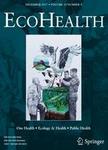版权所有:内蒙古大学图书馆 技术提供:维普资讯• 智图
内蒙古自治区呼和浩特市赛罕区大学西街235号 邮编: 010021

作者机构:Department of Zoology Göteborg University Box 463 SE 405 30 Göteborg Sweden
出 版 物:《EcoHealth》 (EcoHealth)
年 卷 期:2005年第2卷第2期
页 面:138-146页
学科分类:0710[理学-生物学] 0830[工学-环境科学与工程(可授工学、理学、农学学位)] 1004[医学-公共卫生与预防医学(可授医学、理学学位)] 1001[医学-基础医学(可授医学、理学学位)] 08[工学] 0713[理学-生态学]
基 金:Swedish Research Council for Environment, Agricultural Sciences, and Spatial Planning Svenska Forskningsrådet Formas Helge Ax:son Johnsons Stiftelse
主 题:Bioindicator GSSG:GSH Oxidative stress Parus major Pigmentation
摘 要:Measures of oxidative stress in animals may be useful biomarkers of environmental stressors, such as anthropogenic pollution. In birds, studies of oxidative stress have focused on dietary antioxidants, primarily carotenoids, which are interesting due to their multiple physiological and pigmentary functions but therefore also unspecifically related to oxidative stress. A useful complementary biomarker may be the glutathione system, commonly used in human medicine, but rarely applied to wild, terrestrial vertebrates. In this study of urban versus rural adult and nestling great tits Parus major, we investigated both the carotenoid-based yellow plumage (by reflectance spectrometry) and the plasma levels of glutathione, the latter measured as total glutathione (tGSH) and as the ratio between oxidized and reduced glutathione (GSSG:GSH), respectively. We found that urban adults had higher current oxidative stress (GSSG:GSH) and paler yellow plumage compared to rural adults, suggesting elevated stress in the urban environment. Total glutathione levels (tGSH), however, which may indicate long-term up-regulation of the GSH reservoir, did not differ between the environments. Nestlings did not show any consistent pattern between environments in either tGSH or GSSG:GSH and, among individuals, glutathione levels were uncorrelated with carotenoid coloration. The results thus suggest some population-level correspondence between the two stress biomarkers in adult birds, but more work is obviously needed to understand how the two antioxidant systems interact in different individuals and in response to different environmental disturbances. © 2005 EcoHealth Journal Consortium.